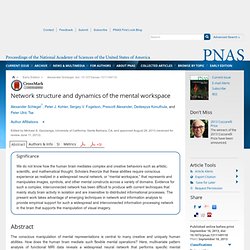

How and where imagination occurs in human brains. Philosophers and scientists have long puzzled over where human imagination comes from.

In other words, what makes humans able to create art, invent tools, think scientifically and perform other incredibly diverse behaviors? The answer, Dartmouth researchers conclude in a new study, lies in a widespread neural network -- the brain's "mental workspace" -- that consciously manipulates images, symbols, ideas and theories and gives humans the laser-like mental focus needed to solve complex problems and come up with new ideas. Their findings, titled "Network structure and dynamics of the mental workspace," appear the week of Sept. 16 in the Proceedings of the National Academy of Sciences. "Our findings move us closer to understanding how the organization of our brains sets us apart from other species and provides such a rich internal playground for us to think freely and creatively," says lead author Alex Schlegel , a graduate student in the Department of Psychological and Brain Sciences.
Dartmouth researchers discover how and where imagination occurs in human brains. Related images(click to enlarge) Alex Schlegel Philosophers and scientists have long puzzled over where human imagination comes from.

In other words, what makes humans able to create art, invent tools, think scientifically and perform other incredibly diverse behaviors? The answer, Dartmouth researchers conclude in a new study, lies in a widespread neural network -- the brain's "mental workspace" -- that consciously manipulates images, symbols, ideas and theories and gives humans the laser-like mental focus needed to solve complex problems and come up with new ideas. Their findings, titled "Network structure and dynamics of the mental workspace," appear the week of Sept. 16 in the Proceedings of the National Academy of Sciences.
Scholars theorize that human imagination requires a widespread neural network in the brain, but evidence for such a "mental workspace" has been difficult to produce with techniques that mainly study brain activity in isolation. Source: Dartmouth College. Where Imagination Lives In The Brain. September 17, 2013 redOrbit Staff & Wire Reports – Your Universe Online While both philosophers and scientists have searched for ages for the biological source of the human imagination, the authors of a paper appearing in this week’s edition of Proceedings of the National Academy of Sciences report that they have located it in the human brain.

In the study, lead author Alex Schlegel, a graduate student in the Dartmouth University Department of Psychological and Brain Sciences, and colleagues report that imagination rests somewhere in a widespread neural network that consciously manipulates images, symbols, ideas and theories while also giving men and women the mental focus needed to come up with new ideas and think scientifically. “Our findings move us closer to understanding how the organization of our brains sets us apart from other species and provides such a rich internal playground for us to think freely and creatively,” Schlegel said in a statement. Network structure and dynamics of the mental workspace.
Author Affiliations Edited by Michael S.

Gazzaniga, University of California, Santa Barbara, CA, and approved August 28, 2013 (received for review June 11, 2013) Significance. How Imagination Works. Dartmouth College. Department of Psychological & Brain Sciences. How Imagination Works (Popular Science) White Matter, Old Dogs, and New Tricks at Dartmouth Most people equate “gray matter” with the brain and its higher functions, such as sensation and perception, but this is only one part of the anatomical puzzle inside our heads.

Another cerebral component is the white matter, which makes up about half the brain by volume and serves as the communications network. The gray matter, with its densely packed nerve cell bodies, does the thinking, the computing, the decision-making. But projecting from these cell bodies are the axons—the network cables. They constitute the white matter. Its color derives from myelin—a fat that wraps around the axons, acting like insulation. Dartmouth graduate student Alex Schlegel reviews brain scans to elucidate the changes in white matter during the process of learning. Alex Schlegel, first author on a paper in the August 2012 Journal of Cognitive Neuroscience, has been using the white matter as a landscape on which to study brain function. Roguecheddar.